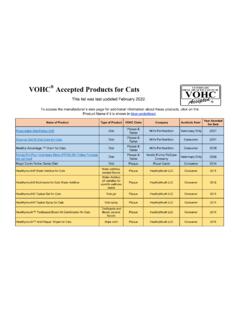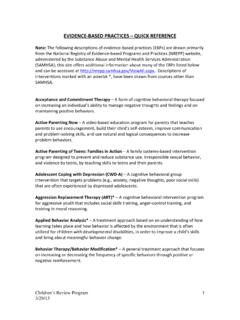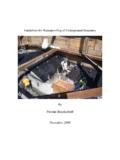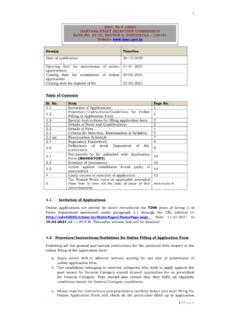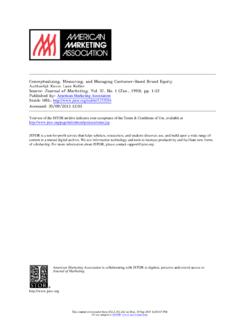Transcription of Scoring Plaque and Calculus - VOHC
1 Scoring Plaque and CalculusColin Harvey, BVSc, FRCVS, DipACVS, DipAVDCD irector, VOHCE uropean Veterinary Dental Forum, Dublin, 2016 Scoring Plaque and CalculusVOHC Function Based on bacteria in Plaque having been demonstrated to be the cause of gingival inflammation and periodontitis, and that dental Calculus exacerbates bacterial Plaque growth, VOHC awards its Accepted Seal to products that meet or exceed a pre-set standard of reduction in accumulation of Plaque and/or Calculus compared with a control group. Therefore, accurate assessment of Plaque and Calculus is essential to the function and credibility of Protocol RequirementMean of 20% reduction in Plaque and/or Calculus accumulation in the two trials - must be at least 15% difference in each trial. This is the same % reduction required to obtain American Dental Association Seal of Acceptance for Plaque /gingivitis and tartar claims for tooth-pastes.
2 If the Scoring system is questionable, the % reduction calculated from the Scoring data is also questionable. Scoring Plaque and CalculusPurpose of this Presentation:To generate interest on seeking ways to improve Plaque and Calculus Scoring methodologies, so that VOHC s Accepted List is determined by trial data produced using best-practice Scoring methods. Scoring Plaque and CalculusItems to be discussed:Brief review of: History of Plaque and Calculus Scoring . Challenges presented by dental Scoring in dogs and cats. Recent progress in Scoring methodsPresentations made at the 2015 Veterinary Dental Forum in Monterey, CA: Baird, Berg, Harvey, Hennet, Miller, Robinson, Scherl, Wallis, Zhang a group effort. The Weak Plaque and CalculusA subjectivevisual observation is the most commonly used technique to evaluate used Plaque and Calculus .
3 The steps are non-linear (ordinal or qualitative data) a score of 4 does not equal twice a score of 2. Result: Accuracy is questionable, and use of parametric statistical tests is Index (1970) modification of the Quigley & Hein PI (962)An attempt to collate location and extent, based on the understanding of pathophysiology of periodontal = No plaque1 = Separate flecks of Plaque at the cervical margin of the = A thin continuous band of Plaque (up to one mm) at the cervical margin of the = Band of Plaque wider than one mm but covering less than one-third of the = Plaque covering at least one-third but less than two thirds of the crown of the = Plaque covering two-thirds or more of the crown of the tooth. Hennet2015A small difference in % coverage may be scored as amajor difference in score, and a major difference in % coverage can be scored as no difference in score.
4 Logan and Boyce Plaque Index, extent of coverage (1994)Record % of coverage seen as disclosed Plaque :0 No Plaque detected1 1 24% covered2 25 49% covered3 50 74% covered4 75 100% covered25%50%75%48%, score =252%, score =373%, score =377%, score = 427%, score =223%, score =1 Shape of TeethThe challenge of assessing % coverage is exacerbated by the irregular shape of the teeth. Where is the line separating 25% from 50%, and 50% from 75%? Are these lines repeatable inter-observer and intra-observer? Mandibular first molar tooth of a dogMaxillary canine tooth of a dogShape is more regular in human teethRelative Size of Teeth Do teeth with very large differences in size merit equal consideration in determining the mean mouth Plaque score? DogCatHumanAgain, less difference in human teethMaxillaryMandibularTooth I 2/3CP3/1P4/2M1CP3/1P4/2M1 Dog %3179267026742535100 Cat %-1004172-72345774 Human %6196757297837466100 Relative Size of Teeth Surface area of whole tooth as % of largest tooth, VOHC set onlySegmentingthe ToothSurface for ScoringHorizontal and vertical lineshave been usedIf donestrictlyby calculation, thereare massive differencesin surface area of one segment vs.
5 OthersHarvey: Shape and size of teeth of dogs and cats: Relevance to studies of Plaque and Calculus accumulation. J Vet Dent 19; 186-195, 2002 Vertical SegmentationSmallest Vertical Segment as % of LargestVOHC Protocol Requirement:Vertical segmentation no longer permitted. Horizontal SegmentationSmallest horizontal segmentation area as % of largest area:Current VOHC Protocol RequirementHorizontal segmentation can be used (and is recommended for canine teeth in cats), but only data from the gingival half can be used for analysis. Hennet et al: Evaluation of the Logan & Boyce Plaque index for the studyof dental Plaque accumulation in dogs. ResVet Sci. 2006; 80(2):175-80 Segmentingthe ToothSurfaceUsingNatural Land-marksWhich still leaves the challenge of assessing irregularareas of Plaque on teeth of irregularshape.. varies in thickness, with increasing thickness indicating increasingly anaerobic, pathogenic Plaque .
6 Extent of coverage is thus an overly simple assessment. Some indices assess thickness on a 1-3 scale based on depth of disclosing solution color, recording only the deep of the deepest area. A composite index is then calculated as coverage score multiplied by the thickness score. If maximum coverage score is 4, and maximum thickness score is 3, maximum composite score is 12. Plaque ThicknessScore Causes DistortionThicknessisrecordedas the maximumdepthof coloranywhereon the toothsurface, but itisnot HennetExample shown: Extent score = 45% = Plaque Index is 2. Thickness score in area of deepest stain = 3. Plaque score = 2 x 3 = 6 (maximum score = 12). But only 10% of Plaque area is Plaque thickness of 3, with 50% of thickness 2 and 40% of thickness 1. Recalculated to reflect thickness, score would be (2 x x 3) = plus (2 x x 2) = 2 plus (2 x x 1) = = Plaque Score = , about half of the score that would be recorded.
7 321 Consistent subjective scoringisnot easy. Requirestraining and experience. VOHC approvesscorers, basedon training, and inter-observer and intra-observer review. HennetIf the Scoring system is questionable, the % reduction calculated from the Scoring data is also What Would Be Ideal for VOHC Use? , accurate, reliable/reproducible, producing quantitative data Scoring extent of coverage and thickness of Plaque or Calculus , similar to a clinical lab chemical analyzer for measurement of glucose concentration in a blood sample. not requiring anesthesia or for both dogs and automatedas possible, to reduce variability. is publicly available and cost-effective. Apples:Applesand not Apples:Orangescomparison. VOHC seeks proof of sufficienteffectiveness. What Are We Measuring? - PlaqueThe primary interest in determining efficacy is extent of Plaque at the gingival margin.
8 Is there value to knowing the extent/thickness of Plaque on the coronal two-thirds of the crown? The actual measurement should reflect the pathogenic potential of the Plaque that is present. Plaque rapidly adheres to the entire tooth surface (except to the extent that it is rubbed off by mechanical action during chewing). Is a method that assesses specific bacteriological properties inherently more valuable than an analysis that measures any material that is stained by a disclosing solution?What Are We Measuring? - CalculusCalculusis not the cause of periodontal disease, but it exacerbates accumulation and maturation of the Plaque biofilm. It is of interest because, unlike Plaque , established Calculus cannot be simply rubbed off the surface of the teeth regular, sustained retardation can be considered to be more critical than Plaque .
9 If accumulation of Calculus is slowed down, there will be a slow-down of accumulation and maturation of Plaque . The primary interest in determining efficacy is extent of Calculus at the gingival margin or subgingivally, as it harbors the Plaque biofilm in the area that results in gingivitis. Digital MeasurementsThe old way:Map Plaque on a template mounted on cardboard, weigh the whole tooth area on the card-board, then cut out the pieces of card board covered by Plaque and weigh the cut-outs on an accurate scale. Software is now available that will permit accurate and semi-automated or automated digital measurements of areas of interest in photographed images. Technical Considerations:Cost and availability of EquipmentTime required to complete the Scoring procedureConsistent positioning and lightingThe result should be Apples:Applesand not Apples:Orangescomparison.
10 Other variables inherent in VOHC trials conducted in dogs and cats body weight, head-shape, age, trial MeasurementsSoftware is now available that will permit accurate digital measurements. Extent of coverage: Number of pixels of a defined color as % of overall area of tooth. Thickness: Depth of color of each pixel ( as a measure of the thickness of the disclosed substrate of interest). Combination of extent and depth would work well for disclosed Plaque , but not for undisclosed Calculus , as the color of Calculus does not deepen with increasing thickness. History of Plaque Digital ImagingExtent of coverage vs. Depth of coverage Combinationbetter than either alone. Verranet al: Feasibility of using automatic image analysis for measuring dental Plaque in situ. J Dent 1986;14:11 et al: Validation of computerized photoimageanalysis (PIA) measurement of Plaque .
